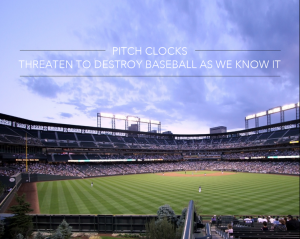BreakingModern — After a postseason in which games dragged on for three hours and 20 minutes on average, Major League Baseball realizes that it must adapt to attract a younger fan base if it’s to thrive in the long run. The pitch clock may be their answer.
What Is a Pitch Clock, Exactly?
 The Boston Globe writes that MLB is testing a “pitch clock” for pitchers, forcing hurlers to throw a pitch every 20 seconds. As part of the pilot program, time between innings was shortened to two minutes and 30 seconds in the Arizona Fall League. Results, so far, have been positive. The games have been shortened on average by 10 minutes. However, the results do not come without a substantial cost. For example, baseball is considering an NBA-like shot clock to add zip to its games.
The Boston Globe writes that MLB is testing a “pitch clock” for pitchers, forcing hurlers to throw a pitch every 20 seconds. As part of the pilot program, time between innings was shortened to two minutes and 30 seconds in the Arizona Fall League. Results, so far, have been positive. The games have been shortened on average by 10 minutes. However, the results do not come without a substantial cost. For example, baseball is considering an NBA-like shot clock to add zip to its games.
Traditionalists and radical “sabermetricians” alike agree that adding even a modest time constraint to baseball tears at the fabric of our national pastime.
Baseball has been an untimed game — players have grown up playing the game at their own pace.
Such players have established rhythms and are not conscious of the clock when having to throw a pitch or get in the batter’s box. It’s also a game of rhythms and routine, especially with MLB’s marathon 162-game season. As a result, adding a clock would disturb the natural flow of the game for players and could lessen the overall quality of play for fans.
Shortening Advertisements Does Not Undermine Revenue

Image: Actionpics/Dollar Photo Club
©
Instead of impairing the level of play, MLB could accomplish its stated goal of shortening games by limiting ad time. Cutting time between innings (from two minutes and 30 seconds to one minute and 35 seconds) would automatically shave nine minutes from game time, while still allowing pitchers to comfortably throw their customary eight warm-up pitches.
Although there would be less time for ad revenue to be accrued, supply and demand suggests that each slot would become more valuable for potential advertisers since there are fewer opportunities. Hence, shortening time between innings might not negatively impact ad revenue for MLB — an organization, according to Forbes magazine, that gathered a record-setting $9 billion dollars in revenue this year. Moreover, the quality of play would remain top-notch, which would also positively affect ad values, making the sport more valuable in the long run to the owners.

Image: Brent Hofacker/Dollar Photo Club
Expedited Games Jilt Loyal Fans
Although the league’s goals are noble in its attempt to shorten play, the results would actually degrade the overall value of the brand in the long run by destroying baseball tradition and hurting quality of performance. Fans would enjoy shorter game times, but would see baseball tradition flaunted. Cutting advertising time would not constitute a major blow to the finances of the sport and might actually enhance revenues in the long run. Most important, it would eliminate the need for the dreaded pitch clock.
The Information Age has dealt a huge blow to baseball — the game is simply too slow-paced for many to stomach. Pitch clocks may attract a small group of newer and younger viewers to the game, but it would be spurning its established fans in doing so.
For BMod, I’m Ben Leonard.







![Who’s Going to Get “Lucky” This NBA Season? [commentary]](../wp-content/uploads/2015/10/HEADER4-60x60.jpg)
![Pete Rose Continues to be Out of Step with Major League Baseball [commentary]](../wp-content/uploads/2015/10/HEADER2-60x60.png)

![Cooking Fever [review]](../wp-content/uploads/2015/11/HEADER1-321x214.png)
![Assassin’s Creed Syndicate [review]](../wp-content/uploads/2015/11/HEADER3-60x60.jpg)
![The Legend of Zelda: A Link to the Past [manga review]](../wp-content/uploads/2015/10/HEADER3-60x60.png)
![Madden NFL Mobile [review]](../wp-content/uploads/2015/09/header3-60x60.jpg)